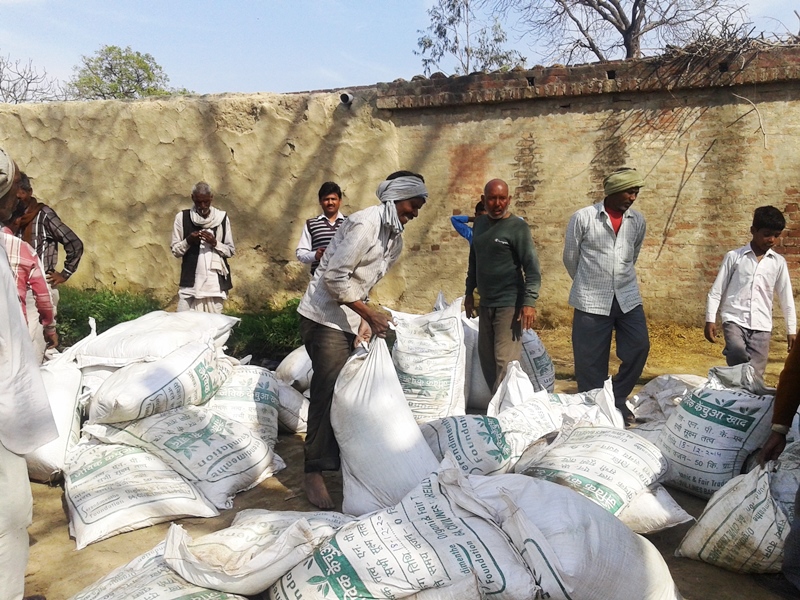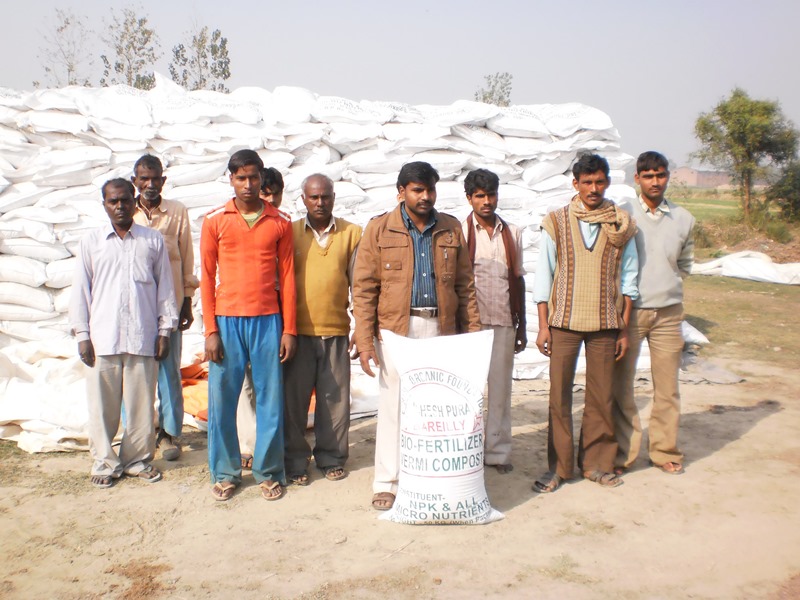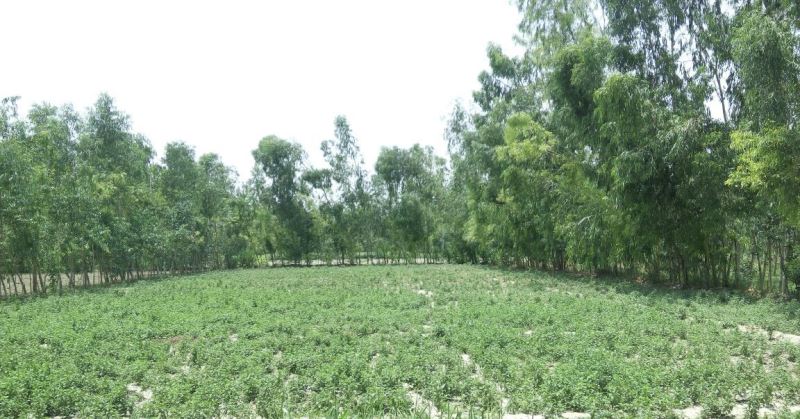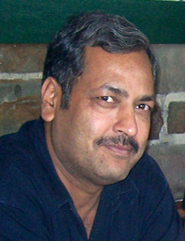
I am just addicted to meeting agripreneurs and hearing about their amazing experiences in doing agriculture better. They do farming a bit differently than ordinary farmers routinely do. Their passion for farming creatively compels me visit them again and again. I can’t stop myself from capturing their motivating stories and sharing with you all. Last week, I met yet again one such amazing agripreneur- 32 years young Mr Nihal Singh in Bareilly district of Northern Indian state Uttar Pradesh. He supports hundreds of farmers in growing certified organic mint, from which mint oil is extracted for export. 629 small scale farmers depend on him for organic inputs, technical advice, linking with certification bodies and tapping the lucrative export market in the Western world. The enterprising spirit of this young ordinary farmer is extraordinary indeed!
Mr Nihal has been linked with global names for quality, like Fair for Life , Serendimenthe , IMO , Phalada and Serendimenthe Organic & Fair Trade Foundation . Mr Nihal is currently running Creation Biotech- a proprietorship firm which promotes organic & FFL (Fair for Life) mint cultivation. Creation Biotech is a merchant exporter supplying Mint Oil to Dr. Bronner’s Magic Soaps, USA. Thanks to these agencies, the local farmers could learn about ways to do farming in more socially and environmentally responsible ways. I found Mr Nihal rearing earthworms on cow dung, weeds, biomass and crop residues to turn it into nutrient-rich vermicompost and supplying it to registered organic mint growers. He offers them technical advice required for high quality certified organic production including registering them as certified growers with Tracenet to ensure organic quality all along value chain.

Mr Nihal has to work hard to meet the quality standards of importers, including social & fair trade requirements . Innovations often are disruptive in nature, since these changes challenge the way we have been doing things. For instance, fair trade projects often face problems as did the Serendimenthe, but it could leave its mark among local farmers on quality fronts. It takes considerable time, skills and efforts in producing bio-inputs, when switching from conventional to organic farming, says Mr Nihal. Risk and challenges are often involved when we try new things like Fair trade and organic agriculture, he says. I guess, Mr Nihal too might have faced many challenges and controversies when establishing a totally new way of farming in the area. True, unless one is determined and strategic like Mr Nihal, possibilities of success are grim.
All mint is not created equal
For its multiple uses , Japanese mint is cultivated in India on about 3 lakh ha. Mentha oil from Mentha Arvensis, also called menthol mint, Japanese mint or corn mint is a major essential oil of India. It is the source of a major raw material for the flavours and fragrances industry. India produced over 35,000 Metric Tonne (MT) of Mentha oil and exported over 25,000 MT in 2014-15 –making it world leader in mint oil. But natural mint faces tough competition from synthetic mint products available on the market at a cheaper rate. Therefore, to protect themselves from unfair competition with synthetic mint, the mint growers also formed Mint Growers Association of India . Yet all is not good with mint especially when grown conventionally; many farmers gave it up finding it a water guzzler . Lucky for them, the craze for all things “organic” is spreading like wild fire all around the world, especially in the developed North-unfolding the huge export market for producers in developing countries. Organic production is a new found opportunity for developing country producers, for which many agencies are offering support including FAO of UN.

Organic agriculture is practiced in 172 countries, and 43.7 million hectares of agricultural land are managed organically by approximately 2.3 million farmers worldwide. The global sales of organic food and drink reached 80 billion US dollars in 2014 .This offers opportunities for farmers in developing countries like India to grow and export organic food, herbs, cosmetics and textiles. No wonder, India has the largest number of organic producers (6,500,000), with an export volume of 263,687 MT worth 298 million USD, and is one among the top organic production and exporting countries in the world. Indian Organic products are exported to the European Union, US, Canada, Switzerland, Korea, Australia, New Zealand, South East Asian countries, Middle East, South Africa, etc. . Having associated with IFOAM and organic movement for over two decades now, I am happy to say that India is hosting the 19th Organic World Congress in 2017 , organized by IFOAM . Welcome to India to learn more about organic agriculture!
Uniting organically
The mint growers in Bareilly area were fragmented and exploited by middlemen until Mr Nihal entered into this business. He organized the mint growers into a potential group, trained them into organic cultivation including social and fair trade requirements, arranged organic inputs and explored the market for organic mint oil in developed countries like UK, USA, and Germany, etc. He learnt the nitty-gritty of trade from the exporters of organic products, particularly those exporting essential oils. The export of agricultural products is something new in this area, so Mr Nihal had to fix many nuts and bolts before he could successfully export mint oil.

There are many more agricultural commodities like mint which, if value is added, could find potential consumers in developed countries for better returns. But we need entrepreneurs like Mr Nihal to help out small scale farmers who often have several handicaps including information, education, technical know–how, inputs, credit and linking to markets.
Indian farmers are eager to make it big and mint organic money. I hope they find many more Nihals in every part of the country!!!
More stories from India on Mint
http://www.businesstoday.in/magazine/reporters-diary/up-farmers-mint-it-big/story/2335.html
https://www.youtube.com/watch?v=AIwxwT8Jr2Y

Guest blog post by Mahesh Chander (drmahesh.chander(at)gmail.com), Head, Division of Extension Education, ICAR- Indian Veterinary Research Institute
The views expressed are personal, and cannot be attributed to ICAR or GFAR.
Photo credits: Dr Mahesh Chander




Thanks a lot, it is very nice to know your views on our project.
its appreciable that Mr Nihal motivating and advising with technical know -how of organic mint production. young entrepreneurs should take Mr Nihal Singh as a role model who is assisting farmers right from production to marketing. Wish him all the best in successful in production of organic mint oil.
Hats off to Mr. Nihal Singh for taking such proactive role as a leading entrepreneur for the welfare of the community members. It is a great pleasure to know that he learnt the nuances of export and cultivation of organic mint from different varied sources. Thanks to Mahesh sir for highlighting his achievements on this reputed forum.
Nice to know about this. Very eager to meet him in person
Hats off Nihal bhaiya ,I m glad to know about you and reading this article on organic revolution in Bareilly district.
I am very excited to meet this successful entrepreneur and to document his success in Telugu for the benefit of farmers along with Dr. Mahesh chander